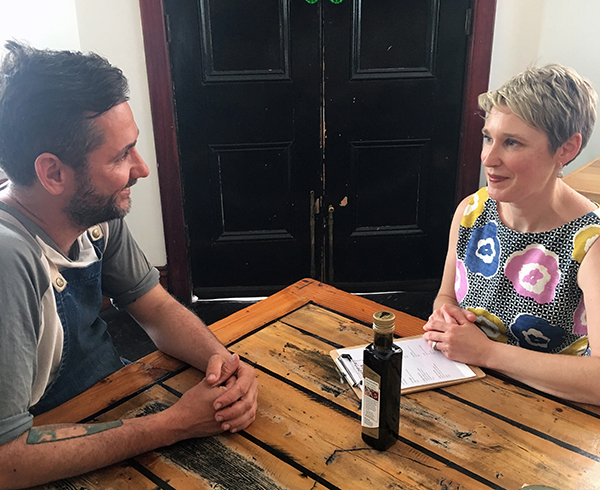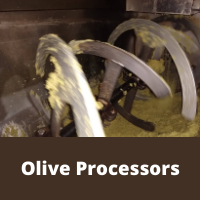
Beth Scholes from Nutrition Australia’s Victorian division speaking with a chef about their EVOO usage.
A series of interviews with local chefs has revealed that they recognise the premium quality of Australian Extra Virgin Olive Oil, but their use of EVOO is limited to ‘finishing’ dishes and using small amounts to add flavour.
Interviews were conducted with chefs from a range of food service outlets including fine dining restaurants, cafes, institutional retail and catering and pubs, to gain an insight into how Australian EVOO is used and the factors that drive its purchase and consumption.
The interviews were part of the Olive Oil Food Service (OL16004) project, a two-year plan to increase awareness of Australian EVOO and produce educational tools for the food service industry.
The project is being delivered by Nutrition Australia in tandem with Hort Innovation, which identified a profound lack of knowledge amongst local chefs as to how EVOO is produced and its benefits, the variety of taste profiles available and its correct storage and use in cooking and food preparation.
Beth Scholes, senior dietitian with Nutrition Australia’s Victorian division, said the interview findings highlighted that whilst most chefs do use and value EVOO and perceive it to be a high-quality product, the oil is only used in small amounts and for specific culinary purposes.
“Most of them used it to ‘finish’ a cooked dish by drizzling it over the top, or they used the oil cold in dressings, sauces and marinades to add flavour,” Ms Scholes said.
“There’s a perception amongst chefs that EVOO should not be used in deep frying or heated to high temperatures, and its use in shallow frying is limited.”
She said the purchase and consumption drivers for EVOO in the food service industry include the cost, taste, quality, access and availability of the oil and its provenance, in line with the increasing trend to promote local produce in food service.
“If Australian EVOO is required for flavour the restaurant chefs might use it for a pasta dish, but in a pub or a café where they’re more price-driven, the chefs said they wouldn’t use EVOO for frying or they’d use an oil other than Australian,” Ms Scholes said.
“There’s no resistance from the chefs to using AEVOO and valuing it, but the research identified a significant opportunity to increase awareness of our oil and its versatility in the food service industry.”
The next step will be to work with a communications agency to develop key messages into a training program for student chefs that fills the knowledge gaps about EVOO, she said.
“While the production costs of Australian EVOO mean it is often more expensive, there’s definitely scope to educate young chefs about the value which comes with the quality of AEVOO: the versatility of the oil, that in fact it can be heated and it maintains flavour, as well as highlighting how it’s produced, the best way to store it and identifying its ‘best before’ date.”
Beth Scholes says everything learnt through talking with existing chefs will be incorporated into an education program, to alter the perceptions of EVOO in the market place.
“I think the common misconception is that you can’t cook with EVOO, that it’s more for salads or served fresh, and that the flavour is the same for all EVOO, whereas we know the flavour is different. It can be altered by the freshness of the oil and there’s a lot of factors that contribute to the taste,” she said.
This project has been funded by Hort Innovation, using the olive research and
development levy and contributions from the Australian Government. Hort Innovation is the grower owned, not-for-profit research and development corporation for Australian horticulture.



